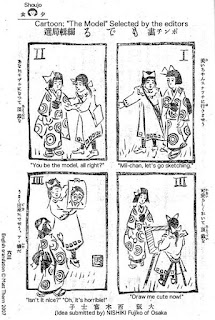Hi, all! Hope everyone has had a pleasant week~
These comics, known as 少女漫画 (rom. "shojo manga"; lit. "young girl comics") have actually been around since the early 20th century. The first female-oriented comics magazine in Japan was know as 少女界 (rom. "Shojo Kai"; lit. "Girls' World")and was published in 1903. I actually managed to find a picture of the cover art for the first ever issue of "Girls' World" (as seen below). Prominently displayed in the center of the image is a wispy, romantic depiction of a young female figure who seems to be throwing flower petals in the wind. Highly stylized flowers compose the foreground.This style of image stands in stark contrast to all types of mainstream comics prevalent in the U.S. market at the time.
少女界 Issue 1 Cover Art
Although "Girls' World" ran out of print after nine years, during the short time that the magazine was in print, many other female-targeted comics magazines had appeared on the market to take its place. Below is an excerpt from the November 1910 issue of a rivaling shojo manga magazine (with translations):
Excerpt from 少女(Shojo), Nov. 1910.
(Note the numbering of the panels - Japanese comics are traditionally read from right to left) 【click image to expand】
As the curator of The Ohio State University's "World of Shojo Manga! Mirrors of Girls' Desires!" exhibit in conjunction with the Billy Ireland Cartoon Library and Museum states, by the 1970s, "many different kinds of manga [were] published for different ages, genders, and fans' favorite themes." Why, then, have we see a very limited range of subject matter and target demographic in the United States up until recent years? Did positions of authority in the States fail to see a sizable female market? Were comics companies fundamentally opposed to the idea of a "female comic" or reaching out to a female demographic? Although "She Makes Comics" did a phenomenal job touching upon the challenges that women faced in the comics world, I think it would be worth while analyzing the factors behind such phenomena, especially given the contrast between the U.S. market and the thriving Japanese female comics market of the time.
That's all for now. See you next week!
-Matt
*****
^Official trailer for "She Makes Comics"
^A teenager discusses negative stigmas about modern day "shojo" comics --- I found that some of the points she makes relate back to comments made in "She Makes Comics" about how people tend to marginalize female viewership, valuing only the elements of a comic that appeal to the traditionally masculine audience.


Hey Matt!
ReplyDeleteAs someone who reads manga, and is female, I 100% get where you're coming from here. The Japanese market presents some really interesting commentary on how the development of comics could have gone really differently. Manga in Japan tends to divide out, as you touched on, into 少女漫画 vs 少年漫画 (shounen). The strict division between boys and girls content expands into art, marketing and structure. Basically the american comic industry disregarded 少女漫画 in favor of the more brutal, less emotionally driven 少年漫画. It is interesting that the division became quite so explicit in Japan and then both branches thrived. Maybe the obvious break expanded the market in a way? I'm not sure either, but it is a huge industry, incredibly prolific and successful in ways that the American industry has failed to maintain.